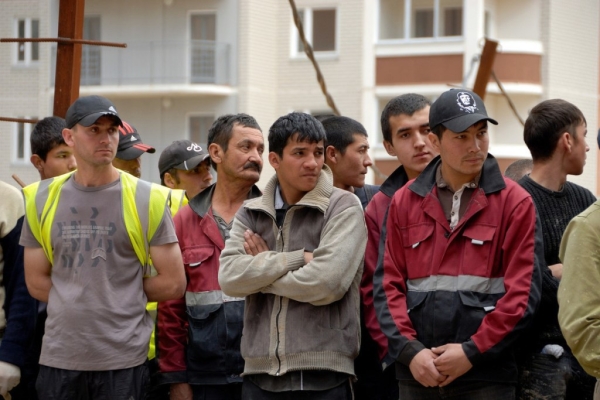
The belief that increased migration leads to a rise in crime is so deeply rooted in public opinion that politicians often find it hard to resist exploiting these sentiments for political gain. However, statistics show there is no such connection—or the relationship is even negative: in societies with large immigrant populations, crime rates tend to decline.
The Insider notes that while crime certainly exists among immigrants, the development of legalization and integration mechanisms helps combat it, whereas restrictions only lead to more violations.
More migration – less crime
Donald Trump’s election campaign largely relied on inflammatory anti-immigrant rhetoric: he claimed that Haitian migrants in Ohio were kidnapping and eating pets, and that Kamala Harris wanted to use taxpayer money to fund gender reassignment surgeries for undocumented immigrants in U.S. prisons.
He also promised to deport 20 million foreigners living in the U.S. without legal status—even though, according to The Washington Post, there aren't even that many visa violators in the country, even when including asylum seekers.
Trump is not alone—right-wing populist parties around the world have made migrants the main target of their criticism and a primary tool for mobilizing their base. Waves of disinformation are often followed by waves of violence, such as the riots in the UK last summer. Similar things happened a century ago—only now, migrants have taken the place of Jews.
Although the number of global migrants has more than doubled from 150 million to over 300 million since 1990, crime rates in developed countries have consistently declined. In the UK, for example, during this same period, property crimes (like theft and robbery) fell from 5,100 to 2,800 cases per year.
Migrants commit fewer crimes
Studies show that first-generation immigrants usually commit fewer crimes than native citizens. In Russia, for example, there are six criminals per 1,000 locals, but only 2–3 per 1,000 among foreigners. Refugees and undocumented immigrants are, on average, more prone to petty theft, document forgery, and other "subsistence crimes" because they are often not allowed to work or support themselves legally—at least until their legal status is settled.
After the European Union accepted eight new member states in 2004, such crimes in the UK decreased because many migrants were able to legalize their status and find work.
Legalizing migrants has little effect on violent crime rates—mainly because first-generation immigrants already break the law less often. However, crime rates do significantly rise among second-generation migrants (those born in the new country).
Why are there so many migrants in prisons?
Switzerland is one of the countries least inclined to legalize and integrate immigrants: even third-generation migrants are still considered foreigners and often cannot obtain citizenship. As a result, Swiss prisons have the highest proportion of immigrants in Europe, although many of them were likely born in the country.
Differences in naturalization policies and how immigrants are recorded in statistics can inflate their prison numbers (e.g., in Switzerland) or understate them (e.g., in France, where naturalized immigrants are no longer counted as migrants).
A lack of social ties and language skills also plays a role—migrants often don’t understand local laws or their rights, and may not know how to contact lawyers or human rights advocates. This puts them at a disadvantage compared to locals.
Finally, a significant number of migrants end up in prison for immigration-related offenses, like violating visa rules, document forgery, or bribing police officers. For example, in 2022, 16% of all crimes committed by migrants in Russia were related to document forgery.
Why do migrants trigger such a reaction?
Victims of crimes committed by migrants are most often other migrants. On one hand, this is because people of the same nationality or background tend to interact within their own communities.
Migrants also frequently settle in poorer neighborhoods, and poverty is directly correlated with higher crime rates. In addition, migrants are less likely to go to the police, fearing unwanted attention from authorities—making them easier targets for criminals.
Because migrants often live in disadvantaged areas and are themselves more often victims of crime than locals, migration becomes wrongly associated with crime. The media worsens this perception by highlighting the ethnicity of non-native perpetrators or even spreading false information.
This distortion is especially noticeable in how terrorism is reported. When attacks are carried out by members of the native population, the media calls them "hate crimes" or "isolated incidents." But when the perpetrator is a Muslim immigrant, it's portrayed as an organized Islamist war against the West. This creates the false public perception that terrorists are exclusively migrants—even though in reality, locals commit more such acts.
Negative stereotypes are also fueled by ethnic criminal gangs. Though they make up a small percentage of the criminal world, their crimes tend to draw more emotional reactions and media attention, casting a shadow over entire communities.
Interestingly, those who oppose migration the most are often people from rural areas, where there are few foreigners. Migrants usually settle in big cities, where support for liberal migration policies is higher.
What policies reduce crime among migrants?
In 2016, current U.S. Vice President J.D. Vance—then a Silicon Valley financier—wrote a column in The Atlantic titled "Opium of the People", in which he described Trump’s xenophobic rhetoric as a form of “cultural heroin.” Politicians like Trump exploit economic dissatisfaction by directing it toward migrants, minorities, and “hostile” foreign countries.
But economic reality shows that the demand for labor continues to drive migration flows regardless of political rhetoric.
In Russia, the flow of migrants has remained stable for many years, despite frequent government promises to tighten immigration laws. After the Crocus City Hall terrorist attack, authorities are simultaneously introducing stricter migration controls and actively bringing in migrants due to a severe labor shortage.
Researchers note that restrictive policies actually increase migrant crime, creating a vicious cycle. By pushing migrants out of the legal sphere, governments limit their chances to integrate and earn a living. This forces them to accept worse working conditions—displacing locals due to cost efficiency for employers—or rely on informal (sometimes criminal) networks, which in turn leads to more crime and public demand for even harsher laws.
Increased police control over migrants leads to a higher number of crimes being recorded among them, further reinforcing the illusion of a migration crisis.




